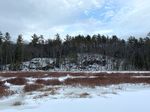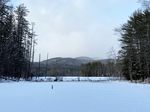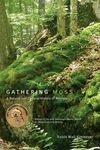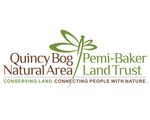Quincy Bog Notes - Quincy Bog Natural Area
←
→
Page content transcription
If your browser does not render page correctly, please read the page content below
Quincy Bog Notes
Conserving Land, Connecting People with Nature
Winter 2020-2021 Volume 28 Number 2
Pioneer Organisms: Lichens and Mosses
Marguerite Crowell
Canadians held an important election last year. It wasn’t for a anti-viral and anti-bacterial medicines and dyes (remember litmus
political office. The vote came at a time when people were re- paper to test the acidity of liquids?). Certain lichens convert ni-
connecting with nature. A group of scientists asked Canadians trogen gas from the air into ammonia and other nitrogen com-
to vote on a proposed national species of lichen. The scientists pounds that are beneficial to plants.
made the case that lichens are diverse, ecologically important,
and have the highest biomass globally in Canada (along with Along with mosses, lichens pre-date all other land plants. They
Russia). Seven candidate species were thoughtfully selected, are ancient! Crustose lichen growth is used to date glacial re-
and the winner was the Star-tipped Reindeer lichen, which treats, landslides, and earthquakes. Lichens are sometimes mis-
looks a bit like cauliflower. Election results went to the Depart- taken for mosses.
ment of Canadian Heritage to make it official.
Mosses are hard to digest and don’t have enough nutrients to be
So, what is a lichen? It’s not a plant, but a partnership between a food source for most animals. Historically, mosses have been
a fungus and algae, or cyanobacteria. Some lichens are used to bandage wounds and purify water, among other uses.
formed of three or more partners. Recent studies show a yeast They hold water in ecosystems and make up the peat found in
as a third symbiotic partner. Yeasts are single-celled fungi. Dr. peat bogs. Quincy Bog is a fen, not a peat bog, but there are
M. Catherine Aime of Purdue University stated that the yeast mosses and lichens growing around the Bog.
likely produces chemicals that help li-
chens ward off predators and repel mi- Mosses are bryophytes. This means
crobes. The study was published in the that they produce spores, rather than
journal Science in July 2016. seeds, and they don’t grow flowers.
Mosses need very little moisture to
"This discovery overturns our survive and can go dormant if neces-
longstanding assumptions about the sary, which why you can find them in
best-studied symbiotic relationship on deserts and in alpine zones, where
the planet. These yeasts comprise a they obtain water from fog. They can
whole lineage that no one knew existed, grow in sub-zero temperatures and
and yet they are in a variety of lichens produce their own "anti-freeze" to
on every continent as a third symbiotic tolerate cold temperatures.
partner,” said Dr. Aime. Interestingly,
they cannot tolerate pollution including Mosses have small root-like parts of
sulfur dioxide, heavy metals, and fluo- their stem that make them great insu-
rine. They are considered “clean air lators. They can be used to insulate a
indicators”. human or animal house/shelter to not
only keep it warm, but also to keep it
In the spring of 2020, Dr. Toby Spribille, cool. Lichen has insulating properties
who studies lichen symbioses at the too, thanks to a lot of air space when
University of Alberta stated, “There’s it’s dry. Some birds and small mam-
something about lichens that forces mals use both lichen and moss in
people to think about working together, their nests. Many invertebrates like
because as soon as people realize that mites and springtails, both found at
it’s a symbiosis ... it gets them thinking Quincy Bog, live in these little micro-
about organisms that work together with Lichen and moss are among the organisms growing on the trunk habitats. This winter, take a walk
of this tree at Quincy Bog.
each other.” According to the Inter- around your yard or neighborhood
mountain Herbarium at Utah State Uni- and see how many different locations
versity, “The basis of the mutualistic symbiosis in lichens is sim- you find lichen and moss. I think you’ll lichen it very moss!
ilar to the mycorrhizal partnership between some species of
Sources:
fungi and the roots of most plants. The lichen fungus provides ❖ www.sciencedaily.com/releases/2019/01/190117142055.htm
its partner(s) a benefit (protection) and gains nutrients in re- ❖ https://science.sciencemag.org/content/353/6298/488
turn.” ❖ www.sciencedaily.com/releases/2016/07/160721151213.htm
❖ www.csmonitor.com/Science/2020/0331/Heads-up-maple-leaf.-Canada-s-
Lichen is an important environmental contributor. It is the main eyeing-another-national-icon
source of food for Canadian caribou in winter months. And ❖ https://herbarium.usu.edu/fun-with-fungi/lichens
caribou are the primary food source of wolves. Lichens are ❖ https://web.mit.edu/12.000/www/m2007/teams/7/final_report/
mosses_lichens2.html
highly adaptable with a wide range of distribution. Crust-like
❖ https://digitalcommons.mtu.edu/cgi/viewcontent.cgi?article=1096&context=bryo-
(crustose) lichens growing on rocks in the deserts of Libya are a ecol-subchapters
critical food source for sheep. And the sheep are critical to the
animal herders. Everything is interconnected. Lichen provides Marguerite Crowell, a Plymouth resident, is VP of the Quincy Bog Board, chairs
the Research & Interpretation and the Communications committees, and serves on
food, shelter, and camouflage to wildlife. For us, it provides
the Pemi-Baker Land Trust Committee.Quincy Bog Notes
President’s Perspective
Gino Infascelli
“Never doubt that a small group of thoughtful, committed citizens can
change the world; indeed, it's the only thing that ever has.”
- Margaret Mead
This past summer my family and I had the opportunity to visit
some of our country’s treasured National Parks. The newest Na-
tional Park is New River Gorge in West Virginia. The December
2020 designation for this multi-use natural area resulted from the Join the Friends of Quincy Bog
cooperation of many entities, including local leaders, businesses,
and outdoor enthusiasts. The site was already a popular desti- The pandemic has changed our lives in so many ways. Perhaps
nation for many outdoor activities, such as hiking, rafting, and you have been unable to travel to visit Quincy Bog as you normal-
camping. With its change in status from a Designated River to a ly would. Or maybe you have just discovered the Bog as you ex-
National Park, traditions of fishing and hunting on 65,000 acres plore areas close to home. Whether you’re a long-time Bog fan or
of the park will be maintained, along with extra protection for new, surely the ability to connect with local natural places, at the
7,000 acres along the river corridor. As the focus of local indus- Bog or elsewhere, has been a balm through a difficult year.
try shifts from coal mining to recreation and conservation, the
new Park is expected to boost the economy and increase visitors Our Board members and volunteers continue their efforts in these
to the area by 20%. strange times, albeit in some different ways (Zoom meetings! Bog
Hosts stationed on the deck! Socially distanced trail work!). We
hope that experiencing the Bog – either in person, or online
through our website, Facebook, or Instagram – has brought you
some happiness over the past year. We look forward to the time
when we can re-open the Nature Center, host public talks and
walks, and interact in person!
Please consider supporting our ongoing work to protect natural
spaces in the Pemi-Baker region, including Quincy Bog, by send-
ing in a donation in the enclosed envelope. Or, if you prefer, visit
our website (www.quincybog.org) and donate through PayPal.
Either way, we appreciate your help so that we can maintain and
improve our trails, share educational materials, conserve special
places, and more. Thanks from all of us to all our friends!
With the winter solstice behind us and daylight extending each
day, I am relieved by positive news on many fronts as we start a
new year. I am hopeful that, by the summer solstice, our health
care providers, first responders, and those who support them will
be rewarded by some much-needed rest and the time off they
deserve.
I am very grateful for recent snow that allows for the winter activi-
ties many of us enjoy and helps support our local economy. I
relish my quiet time in the woods, snowshoeing and looking for
animal tracks added since the last round of snow flurries. It’s
reassuring to know they are there.
During this last year, through the help of many volunteers some
of the salvageable wooden pieces of the old board walk at
Quincy Bog were repurposed to elevate other wet sections of the
trail. This recycling saved a significant amount of time and effort.
We would like to thank Bob Berti, Bob Bulkeley, and Charlie
Chandler, our retiring board members, for over 50 years of com-
bined service and dedication to protecting many lands here in the
Pemi–Baker watershed that provide recreational and educational
opportunities to the public.
We wish all of you a peaceful, healthy, and happy new year.
Gino Infascelli, a Campton resident, likes to be hands-on with trail work and de-
votes many hours a year to our conservation efforts.
Page 2Winter 2020-2021
Junior Naturalist Corner
Marguerite Crowell
Do you know that lichen are not plants? They Taking a Liking dormant (become inactive temporarily). This is
are made up of a fungus, an alga, and a yeast. called "poikilohydry" (say it out loud -- poyk ill
This multiple-species relationship is called to Lichen oh hy dry)! Cool word!
symbiosis and is an example of mutualism,
where each organism benefits from their rela- Have you ever crushed lichen while walking
tionship. The organisms in a lichen exchange in the woods?
food, water, and carbon dioxide. To the right Don’t worry! Little fragments that break off and
(on the top) is a photo of foliose lichen growing get stuck in your shoe or the fur of wildlife get
on a tree. carried to a new place. That's how new lichen
colonies form!
What did the alga say to the fungus about
their symbiotic relationship? I’m lichen it! Cool Fact—Lichen biomonitoring in Milan, Italy
shows air quality (how much pollution is there).
Cool Fact—Some patches of an Arctic species called Lichen was removed from a healthy area outside
"map lichen" (Rhizocarpon geographicum) appar- the city, placed into several bags (shown in the
ently started growing 8,600 years ago, so they may bottom photo to the left) and hung in different
be the world's oldest living organisms! places in the city on tree branches about six feet
(wikipedia.org/wiki/Lichen) off the ground. The study ran for three months
during winter, when lichen were “active”. The sci-
When lichens are dry, are they actually entists found that many heavy metals (toxic) were
dead?
absorbed or soaked up by the lichen! They pub-
When lichens are wet, they "turn on" and start lished their research in a journal called Applied
photosynthesizing and growing. When lichens Science in March 2020.
are dry, they "turn off", become brittle, and go
Marguerite Crowell has a keen eye and ear for fun facts and stories that appeal to younger readers. She applies this skill to the content for the Junior Naturalist section.
clever adaptations to both trap water and keep it from evaporat-
Books We’re Reading at the Bog ing. Of course, one of their best parlor tricks is to nearly totally
desiccate, down to 2% of their usual water volume, and wait.
Gathering Moss They wait, dried and withered, for moister conditions to return. In
A review submitted by Mark Runquist the laboratory, dried mosses have revived after 40 years without
water. Hanging around Earth for 320 million years gives you all
Even though mosses are common kinds of strategies.
in New England forests, most are
known only by their scientific Not only does the book offer an overview of the history, forms,
names – and with hundreds of and functions of moss, Kimmerer weaves in stories of her family,
species in New Hampshire, things primarily from her home in upstate New York. She investigates
without a name are often times not pioneering moss on mine tailing sites and in tropical rain forests.
noticed. I was one of those whose She also describes the herculean efforts of a well-meaning, but
head held a very large bucket of misguided man trying to recreate all manner of natural wonders
many different species recognized on a bare piece of ground, including a moss-covered rock cliff.
only as “moss.” After reading the book, I now notice moss everywhere – not only
But dig into the biology and the where I expect to see it, but also in sidewalk cracks and bare
luscious language of mosses and rocks – and now that I know how
you learn that the leafy green long it can wait for water, it makes
shoots are called gametophytes. sense in these seemingly inhospita-
Little brown doo-dads on top are ble places. After all, following its
sporophytes, and it goes on. The evolution as one of the first land
understanding of each new word plants, surviving in a crack in the
brings a deeper way to observe and appreciate mosses. sidewalk or in a shingle is no prob-
lem! This book opens a new frontier
In her book, Gathering Moss: A Natural and Cultural History of to explore this pioneering plant,
Mosses, author Robin Wall Kimmerer brings the perspectives of when not otherwise distracted with
a scientist and a Native American, accustomed to multiple ways the birds, trees, flowers, and rocks
of “knowing”. She urges us to listen and understand what moss that usually grab our attention.
can tell us. As some of the first organisms to find a home on
Mark Runquist, a Campton resident, frequently
land, she thinks of mosses as the amphibians of the plant world. reviews books for Bog Notes. In moving to New
Not capable of pulling water from the soil, they have devised Hampshire 5 years ago, he feels he has come
“home to a place he'd never been before.”
Page 3Board of Directors
Rumney Ecological Systems
administrators of
Quincy Bog Natural Area
and
Pemi-Baker Land Trust
P.O. Box 90, Rumney, NH 03266
President Gino Infascelli, 2012, Campton
Vice President Marguerite Crowell, 2012,
Plymouth
Secretary Kerry Yurewicz, 2008, Plymouth
Treasurer Robert Berti, 1996, Rumney
Directors
Patricia Barker, 1981, Campton
Lisa Doner, 2014, Plymouth
Amy Dupuis, 2019, Rumney
Judi Hall, 2017, Rumney
Jessica Halm, 2018, Campton
Widge Kent, 2002, Plymouth
Janice Mulherin, 2011, Rumney
David Peeler, 2014, Campton
Mark Runquist, 2019, Campton
Betty Jo Taffe, 1994, Rumney
Paul Wilson, 2018, Bridgewater
Names are followed by the year of joining Board.
Founding Director
George (Joe) Kent*, Rumney
Directors Emeritus
Allan R. Keith*, Chilmark, MA
Warren King, Ripton, VT
George “Al” Ports, Concord
Bill Taffe, Rumney
*member of original Board
Quincy Bog Notes is a twice-yearly newsletter of information, announcements, and news
Editors: Lisa Doner & Kerry Yurewicz
Contact us: bognotes@quincybog.org
about the Quincy Bog Natural Area and Pemi-Baker Land Trust.
Quincy Bog Natural Area, 131 Quincy Bog Road, Rumney, NH, 03266, www.quincybog.org
Quincy Bog Notes
Bulkeley Bridge
The next time you visit Quincy Bog, you are sure to notice a new
sign along the trail. We have named the pontoon bridge over the
outlet stream on the south side of the Bog in honor of Bob Bulke-
ley, who recently retired from the Board of Directors after sixteen
years of service. Bob made many important contributions to the
Bog, but among the most notable was his dedicated work on the
trail. In fact, our pontoon bridge was his vision, implemented as
an innovative way to deal with the fluctuating water levels at the
Bog. (If you’d like to read more about this bridge and the history
of the Quincy Bog trail, be sure to check out Bob’s article in the
Winter 2019-20 edition of Bog Notes, available on our website).
The view from Bulkeley Bridge is tough to beat, whatever the season!
Stay Tuned Online for Program Updates
Normally, in our winter newsletter we post some “Save the Date”
notices for our earliest programs. This year, it’s too soon to know
just what our plans for spring and summer walks and talks may
be. Please stay tuned to our website (www.quincybog.org) and
Facebook page (www.facebook.com/QuincyBogNaturalArea) for
updates as the year progresses.You can also read

























































